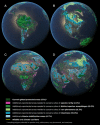A "Global Safety Net" to reverse biodiversity loss and stabilize Earth's climate
- PMID: 32917614
- PMCID: PMC7473742
- DOI: 10.1126/sciadv.abb2824
A "Global Safety Net" to reverse biodiversity loss and stabilize Earth's climate
Abstract
Global strategies to halt the dual crises of biodiversity loss and climate change are often formulated separately, even though they are interdependent and risk failure if pursued in isolation. The Global Safety Net maps how expanded nature conservation addresses both overarching threats. We identify 50% of the terrestrial realm that, if conserved, would reverse further biodiversity loss, prevent CO2 emissions from land conversion, and enhance natural carbon removal. This framework shows that, beyond the 15.1% land area currently protected, 35.3% of land area is needed to conserve additional sites of particular importance for biodiversity and stabilize the climate. Fifty ecoregions and 20 countries contribute disproportionately to proposed targets. Indigenous lands overlap extensively with the Global Safety Net. Conserving the Global Safety Net could support public health by reducing the potential for zoonotic diseases like COVID-19 from emerging in the future.
Copyright © 2020 The Authors, some rights reserved; exclusive licensee American Association for the Advancement of Science. No claim to original U.S. Government Works. Distributed under a Creative Commons Attribution NonCommercial License 4.0 (CC BY-NC).
Figures



References
-
- Dinerstein E., Olson D., Joshi A., Vynne C., Burgess N. D., Wikramanayake E., Hahn N., Palminteri S., Hedao P., Noss R., Hansen M., Locke H., Ellis E. C., Jones B., Barber C. V., Hayes R., Kormos C., Martin V., Crist E., Sechrest W., Price L., Baillie J. E. M., Weeden D., Suckling K., Davis C., Sizer N., Moore R., Thau D., Birch T., Potapov P., Turubanova S., Tyukavina A., de Souza N., Pintea L., Brito J. C., Llewellyn O. A., Miller A. G., Patzelt A., Ghazanfar S. A., Timberlake J., Klöser H., Shennan-Farpon Y., Kindt R., Lillesø J.-P. B., van Breugel P., Graudal L., Voge M., Al-Shammari K. F., Saleem M., An ecoregion-based approach to protecting half the terrestrial realm. Bioscience 67, 534–545 (2017). - PMC - PubMed
-
- Kennedy C. M., Oakleaf J. R., Theobald D. M., Baruch-Mordo S., Kiesecker J., Managing the middle: A shift in conservation priorities based on the global human modification gradient. Glob. Chang. Biol. 25, 811–826 (2019). - PubMed
-
- Allan J. R., Possingham H. P., Atkinson S. C., Waldron A., Di Marco M., Adams V. M., Butchart S. H. M., Venter O., Maron M., Williams B. A., Jones K. R., Visconti P., Wintle B. A., Reside A. E., Watson J. E. M., Conservation attention necessary across at least 44% of Earth’s terrestrial area to safeguard biodiversity. bioRxiv, 839977 (2019).
-
- Noss R. F., Dobson A. P., Baldwin R., Beier P., Davis C. R., Dellasala D. A., Francis J., Locke H., Nowak K., Lopez R., Reining C., Trombulak S. C., Tabor G., Bolder thinking for conservation. Conserv. Biol. 26, 1–4 (2012). - PubMed
-
- T. E. Lovejoy, L. Hannah, Eds. Biodiversity and Climate Change: Transforming the Biosphere (Yale Univ. Press, 2019).
Publication types
MeSH terms
LinkOut - more resources
Full Text Sources
Medical

